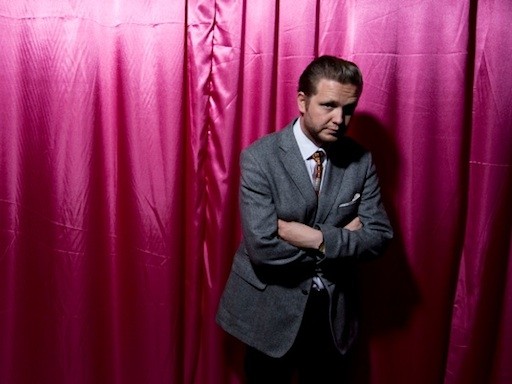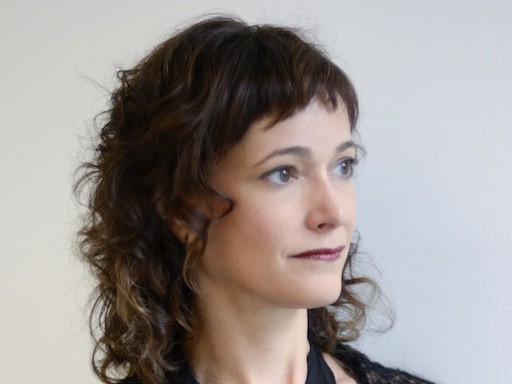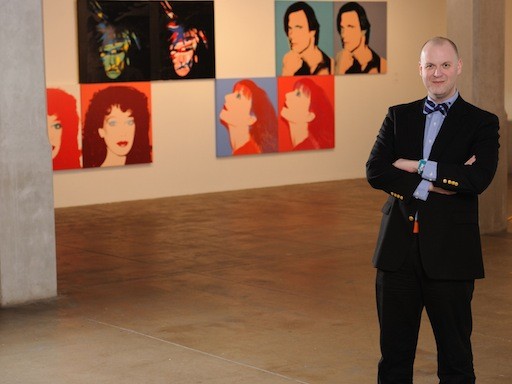In an art world that all too often resembles a boys’ club, the artist Deborah Kass has long been an agent provocateur on behalf of the feminist perspective, infiltrating the male spotlight through works freighted with her own Jewish female identity. This has been the primary focus of her so-called “Art History” paintings, in which she detournes famous images by artists like Andy Warhol and Frank Stella to incorporate her own viewpoint, such as in her series of paintings sneaking her own face into the Pop artist’s self-portraits.
Warhol, indeed, has been Kass’s Trojan horse of choice, as can be seen from her My Elvis series—now on view at Paul Kasmin Gallery along with three of the self-portraits—which she began in the early 1990s by replacing the Pop artist’s iconic portraits of the swivel-hipped rocker with Yentl, Barbra Streisand’s cross-dressing character from the 1983 film of the same name. That Yentl is about a devout Jewish woman who disguises herself as a man to study the Torah puts a deliciously subversive gloss on Kass’s appropriative sacrilege.
Kass has had a busy couple of months, with her work featured in a recent solo exhibition at the Andy Warhol Museum in Pittsburgh as well as the Metropolitan Museum of Art’s major exhibition Regarding Warhol: Sixty Artists, Fifty Years, a show examining Warhol’s influence on younger artists that is touring to the Warhol Museum in February. We spoke to the artist about her work, and her ongoing engagement with the master of the Campbell’s Soup can.
For years you have engaged in a wrestling match with Warhol’s legacy. Are there any visual artists practicing today whom you see as particularly close descendants of Warhol’s work?
Jeff Koons reminds me of Andy Warhol in one way. John Waters reminds me of Andy Warhol in another way. The thing with Andy is that there are so many aspects of him—that’s the point. There’s the branding aspect, there’s the process aspect, there’s the celebrity-culture aspect, there’s the product, the portraiture, the commercial aspect. There are all these different aspects to him and to what he meant that people really take off from. I mean that’s why he’s such a seminal figure, to use the word “seminal.” It’s like there’s so much to latch on to there for people to use. Sort of like Picasso. A lot like Picasso.
In your Art History paintings, you incorporate your own personal touches into the iconic motifs and styles of a number of different artists. When you created those paintings, did you also aim to mimic their artistic approaches and technical processes as well as their imagery?
You mean did I start to smoke cigars? [Laughs]
How did you get in character, I guess?
Oh, it was just the process—just learning a new way to paint.
Considering that these artists are celebrated for their unique approaches, that can’t be easy. Was there a learning curve?
There probably was, but I tend to jump in before I learn, which is a mistake. But that was true of everybody I’ve ever used. I don’t think it through, I just sort of do things and then I make mistakes and have to learn from them because my body’s gone first and my head’s gone second. I did the best I can, but I really have to learn to consider my thought process. I act first, I think later. It’s really the story of my life.
You’ve shown your series Feel Good Paintings for Feel Bad Times on multiple occasions at Paul Kasmin Gallery. Do you think we’re still in “Feel Bad Times?” Do we still need “Feel Good Paintings”?
Well I feel good about Obama. When I made those I started with Bush. I found Obama’s first term to be really grim, and while I definitely have more optimism at the moment, we’ll see. It’s very guarded optimism. The obstruction of the first four years was really upsetting and really depressing, and it almost looked like the job was impossible. What we hired him to fix may not be fixable. But I’m always Chicken Little. The sky is always falling. It’s not very optimistic.
You’ve previously mentioned that you felt that the 1970s were the only decade in which female artists were considered on par with their male colleagues. Is there a sea change occurring in the present moment, with prominent institutions showing major exhibitions of female artists?
I think things will change as the people in power age out of the system, and I think that’s what you’re seeing. Younger people have been educated in a very different way than my generation, but I don’t see where it’s gotten much better for women in the art world in general. The politics of generations change as the generations change, and, in my humble opinion, younger people are better educated than my generation was because they have things like women’s studies, which my generation didn’t have. So the daughters all get it, the sons all get it, and even if you don’t take it you know there is such a things as women’s studies, and queer studies, and black studies. Those definitely didn’t exist in the ‘70s when I went to school, so now people get a different education and a different political baseline.
Do you feel that the artist has a responsibility in society to bring those issues to the fore?
I don’t know what an artist’s job is at all anymore. But if that is your interest then it is your responsibility.
When you say you don’t know anymore, have you changed your mind from what you’d thought previously?
I thought I knew a lot when I was younger, but I don’t know anything I thought I knew. [Laughs] I was sure about much more then, but it’s been a long time since I’ve given a prescription for what an artist should do or must do. I think people decide that for themselves and then they make the work depending on that. Its reception is another story, though, and I think as an artist you do have to understand who your audience is.
Do you make work with an audience in mind?
I think you can if you want. If you’re interested in communicating, you must be interested in the people you’re communicating to. I actually believe art is about communication, and that the nature of the communication and the aim of the communication is up to you as the artist, but I think you want to engage an audience because you want to engage the world. Again, I don’t want to be prescriptive, but that’s certainly what I’m interested in: engaging with the world.
To ask you to be prescriptive just once more, do you have any advice for young artists today? Are there any lessons you’ve learned that you’d like to pass on?
“Don’t be an asshole,” that’s what I always tell my students. Be respectful. I guess I would just say that the people you know now are people you’re probably going to know the rest of your life, so treat them accordingly. The biggest nerd is probably going to be the biggest success. Don’t write anyone off. Be respectful of your peers because if they’re lucky and you’re lucky, you’re going to know each other for a long time.
How do you feel your work has changed over the course of your career?
Well, it really changed in the late ‘80s when I found my subject. And once I understood the context within which I wanted my work to participate, that really changed my work. After that moment in the late ‘80s, like with the Art History paintings… it’s so corny, but it’s just following the work, going where the work took me. I think that the older you get, the more things change. The work follows you, you follow the work—it’s like this really nice dance, if you’re lucky, for your whole life.
What would you say is the singular essence of a Deborah Kass work? Is there anything in particular you want the viewer to take away from it?
You know what’s really funny? [The art historian] Irving Sandler said this great thing to me about this topic. He said, “How come, if you’re always appropriating other artists, it always looks like a Deborah Kass?” And I thought that was just the greatest thing anyone’s ever said. I couldn’t identify the quality, but Irving seemed to see it.
Is there anywhere in particular you look for inspiration?
I really look at the art I love, and I really look at popular culture, and I really look at politics, and they all inspire me equally.
Do you collect any art yourself?
I do collect a little art. I have my little collection of Warhol works on paper. We have a lot of stuff on paper—that’s what we could afford—and we ended up somehow with a really decent collection of drawings and prints. And we’ve supported some younger artists over the years, too.
Which artists do you have in your collection?
We have Elizabeth Murray, a couple drawings, a beautiful little print; Guston; Warhol; those cheap infinite-edition Cindy Shermans; a couple of really beat-up Robert Indianas. I got lucky—my friend was friends with Indiana, so I got what he had—but some of this stuff is just really beat up. Who cares? I’ve got a great Lichtenstein. I’ve got a Warhol’s Race Riot from a Marlborough Pop print sale a hundred years ago. And we paid nothing for this stuff—it was just through scouting. Laurie Simmons, Lee Bontecou, Sister Corita. We’re really excited—we just got four Sister Corita prints. They haven’t even been unpacked yet. I have such a rush from getting these, I can’t even tell you. I can’t wait to put them up.
Do you have any advice for current collectors?
Always buy what you love and never think twice about it. I wish I’d done more collecting of what I loved, because I should have. But it’s a money thing. If you don’t have money you can’t do it, but if you have a little money you can do it. Everything I have I bought really cheap and I’ve had for a really, really long time. When Paul Kasmin had an Andy Warhol drawings show I bought two beautiful drawings, and that’s the most I ever spent on anything. Those were expensive. I probably overspent, but I really wanted an Andy drawing. But the rest of the stuff I got cheap—for instance, Elizabeth Murray traded with me. It’s got to be cheap for me to buy it, but I wish I could’ve stuck my neck out more over the years.
So would you encourage people to follow their hearts when collecting rather than always their heads?
Well, not to the bitter end, but I’m an impulsive person. I’ve found that following my impulses works out generally—except when I’m supposed to be learning a new thing for an Art History painting. I wish I had more money to follow my impulses, but I absolutely encourage people to follow theirs. And people should be trading with each other. I just traded a Chuck Close for a Barbara after Chuck asked me to. So now we have this beautiful, gorgeous self-portrait of Chuck. You should always trade with your friends. You should trade early and trade often.
Q&ADeborah Kass on Warhol, Painting, & Trading Art With Chuck Close
























